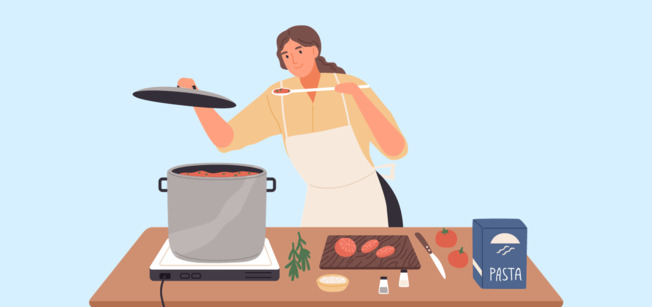
How to Lower Your Apartment’s Heating Bill

By Lilly Milman
Oct 31, 2023
The nights have gotten colder, the space heaters have come on, and the window air conditioning units have been taken out. Summer is over, sadly, and apartment heating season is here — whether you’re ready for it or not.
The winter can be stressful because — depending on where you live, heating bills can be an astronomical expense. Plus, you may be more likely to be at home more often when it’s cold, so you’ll have no choice but to keep the heater running. You don’t need to worry, though, because there are plenty of ways to reduce heating costs without breaking the bank.
We have low-cost, energy-saving tips to help you get ready to keep the cold out and your utility costs low this year.
Insulate Your Windows
According to the US Department of Energy, about 30% of a home’s heating is lost through its windows. So, the first step to making your apartment more energy efficient is by insulating them.
Buy a Window Insulation Kit
You can buy a window insulation kit at any hardware store, usually for $20 or less. This kit will come with double-sided tape and plastic film, which you can use to cover your windows. This will keep warm air from escaping — and can save you hundreds of dollars in heating bills over the course of the winter months. While we recommend insulating all of your windows for maximum energy efficiency, you can start with the ones where you feel airflow even when the window is closed.
Add Some Heavy Curtains
For even more insulation, consider purchasing curtains for your window as well if you don’t have them already. While many interior designers recommend lighter, gauzy curtains for spring and summer, the fall and winter are the perfect time to swap them out for heavier curtains. Not only do they add a level of coziness to your décor, but they are also functional. Closing heavy curtains after the sun goes down will decrease the amount of heat you lose to drafts and opening them up during the daytime will allow the sunlight to shine in and naturally heat your home. While this may be a bigger expense than the other tips on our list, they are a one-time purchase that can help you save money in the long term by decreasing heat loss (and, as a result, energy consumption).
Make Sure Your Doors Seal
Like the windows, the doors in your apartment are another area where you stand to lose significant heat. Especially if you live in an older building, your doors may not properly seal when they are shut — and the resulting air leaks and drafts may be the culprit draining your bank account when you are paying your heating bill.
Install Draft Seals
If you can feel cold air coming in when you’re standing by the door or see any space between the door and the floor, then it’s time to invest in a low-cost draft seal to prevent heat loss. You should be able to order one online on a website like Amazon or pick one up from a hardware store for less than $15. To install a door seal, you will either stick it on to the door with an adhesive or slide it on to the bottom of the door. For a free alternative, roll up a tower or blanket and place it in front of or under the door.
Bolt the Door
If you and your roommates are home and don’t plan on leaving your apartment for the night, bolt your door shut to help keep heat in. Locking the door will help ensure that your door is completely closed, and not letting any air escape. Just make sure you don’t lock anyone out.
Close Doors to Unused Rooms
If you have a guest room or office that is going unused, or a roommate who is rarely home, make sure their door stays shut and the vent in their room is closed. Heating up an unused room leads to unnecessary energy usage and can end up raising your utility bills. Of course, you can open up the vent and door again if someone plans on using the room.
Use Décor to Your Advantage
Your furniture and décor placement can affect how well your home gets heated, and making some slight adjustments can have a big impact.
Keep Furniture Off of Vents
Figure out where your vents are and keep your furniture away. For example, if a couch is on top of a heating vent on the floor, then it can be blocking the hot air from getting to the rest of the room. Moving it out of the way will help your apartment warm up faster and more efficiently.
Go Rug Shopping
If you are suffering from cold feet every winter, it’s time to go rug shopping. Spruce up your living room or bedroom with an area rug, which will protect you from cold hardwood or linoleum floors and insulate your apartment. Rugs also have another benefit: If you have loud downstairs neighbors, a rug can also help soundproof your apartment. Just make sure your rugs aren’t covering any heating vents, per our last tip.
Swap Out Your Bedding
It’s no surprise that your apartment gets coldest at night after the sun goes down — but instead of pumping the heat all night, you may want to consider swapping your bedding first. Flannel sheets will be much warmer than cotton and will also add a cozy look and feel to your bedroom.
Invest in Some Effective Devices
If you’re worried about being too cold once you turn your thermostat down, there are a few devices that can make it a little easier on you.
Use a Space Heater in a Pinch
While it may seem counterintuitive to turn down your thermostat and up the electric bill by turning on your space heater, the latter may end up costing less than the former in the long term. Turning on a space heater is an effective temporary solution if you are only going to be home for a short amount of time and don’t want to waste energy by heating up the whole apartment. Just make sure that you do not plug a space heater into a power strip, keep it too close to any furniture or flammable item, or forget to unplug it when you are done using it.
Combat Dry Air with a Humidifier
Just like in the summer, when high humidity makes it feel like it’s warmer, dry air can feel colder in the winter. A low-cost humidifier can help combat this inside your home. Not to mention, the damper air will help you prevent dry skin and keep you more comfortable all season long.
Turn Down Your Thermostat
After you’ve made all of the above changes to winterize your apartment, it’s time to trust the process and turn down the thermostat (if your apartment has a programmable thermostat to begin with). If your apartment has been properly insulated, it should stay warm even if your heat is turned way down — while using much less energy.
Just keep in mind: The World Health Organization (WHO) does not recommend setting your thermostat below 64 degrees while you are home. Setting it lower can have negative impacts on your health and could lead to your pipes freezing.
If you live in an area with a designated heating season, there may be a legal temperature range that apartments must stay within. For example, in Massachusetts, heating season is between September 15 and June 15 — during which landlords are required to maintain a temperature between 68 and 78 degrees F in each habitable room from 7:00 a.m. to 11:00 p.m. This doesn't mean that heat cannot be turned off at any point during that time, but that the temperature of the unit must be kept within that range.
The Bottom Line
Hopefully, you are feeling more prepared for the cold winter months ahead now that you’re armed with tips for insulating your apartment and lowering your energy costs. However, if you have more questions about apartment heat, check out our guide on 6 Things Every Renter Needs to Know About Apartment Heat.
Top cities
Atlanta Apartments
1,977 apartments starting at $600/month
Austin Apartments
4,908 apartments starting at $600/month
Baltimore Apartments
1,455 apartments starting at $500/month
Boston Apartments
3,442 apartments starting at $940/month
Charlotte Apartments
2,848 apartments starting at $450/month
Chicago Apartments
3,995 apartments starting at $450/month
Dallas Apartments
5,609 apartments starting at $604/month
Fort Worth Apartments
2,199 apartments starting at $600/month
Houston Apartments
4,451 apartments starting at $600/month
Las Vegas Apartments
1,080 apartments starting at $704/month
Los Angeles Apartments
10,138 apartments starting at $625/month
Miami Apartments
553 apartments starting at $1,000/month
Milwaukee Apartments
903 apartments starting at $465/month
New York Apartments
3,690 apartments starting at $550/month
Oakland Apartments
605 apartments starting at $750/month
Orlando Apartments
845 apartments starting at $850/month
Philadelphia Apartments
3,579 apartments starting at $550/month
Phoenix Apartments
4,147 apartments starting at $611/month
Pittsburgh Apartments
1,223 apartments starting at $600/month
Portland Apartments
2,592 apartments starting at $599/month
Raleigh Apartments
1,358 apartments starting at $750/month
San Antonio Apartments
3,942 apartments starting at $525/month
San Diego Apartments
2,957 apartments starting at $650/month
San Francisco Apartments
440 apartments starting at $675/month
San Jose Apartments
409 apartments starting at $1,300/month
Seattle Apartments
3,620 apartments starting at $450/month
Tampa Apartments
1,050 apartments starting at $800/month
Washington DC Apartments
2,945 apartments starting at $745/month


